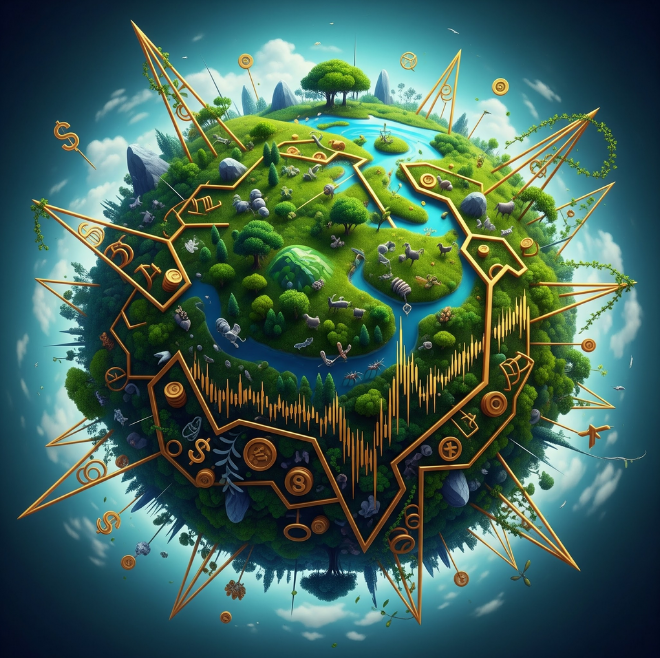Chapter 1
The Embedded Economy: A Critical Analysis of the Manufactured Conflict Between Environment and Development

Introduction
The widespread reluctance to "accept" that the environment is the non-negotiable foundation of all development is not a simple oversight. Still, it is the logical and necessary outcome of a disembedded economic paradigm of treating nature as a "fictitious commodity”. Many believe that there is a strong contention that denies it. Man discovers and gives his interpretation of his choice and the compulsion of denial. This system is driven by a structural need to resolve its own "second contradiction” by externalising costs, a process enabled by a deep "logic of domination" and sustained by "cultural hegemony”. The challenge is not to "accept" a new fact due to existing dogmatic assumptions, which is driven by the compulsion of denial. By keeping away from the fact that the environment is developing, the structural slumbering is created with an identical analysis of myth.
Environment and Development
The environment brings development. All economic value originates from "ecosystem services" and low-entropy energy/matter. Adam Smith considered the land as a factor of production with labour and capital. The labour and capital are unlimited, but the land is limited, while considering the land with rent, David Ricardo concluded. Here the nature is considered the provider of raw material, and the fact is denied that nature is the source of development. Val Plumwood found the paradigm shifts in the analysis of factors of production as contented in the analysis of Adam Smith.
Development Unavoidable
Karl Polanyi argues that the truly "unavoidable" element is the system's need to protect itself through the analysis of the pre-capitalist economies that were "embedded" in society and nature, while the Industrial Revolution "disembedded" the market, making society subservient to its logic. Hence, the "unavoidable development" is actually the unavoidable logic of this disembedded market. Amartya Sen has developed the analysis of the “Capability Approach”, which is the human evolution of development. Man grows and nourishes his capability towards development consistently. Accordingly, the development is unavoidable. There is a systemic analysis of the perpetual growth of GDP to remain stable, and it disengages nature from development. Karl Polanyi differs from the ‘treadmill of production” of Allan Schnaiberg in terms of GDP.
Not Accepting This Fallacy
Power is the broker of fallacy to recognise or to deny it. Economic adventurism enormously outplays the truth in the absence of rationality and analytical wisdom. Seldom is the exception the rule in this game. Nature is termed as a product for sale, and everyone has the opportunity to buy it in the market. The philosophical interpretation of sustainable development revolves around it. The division of labour has improved the efficiency of production, and the division of wealth reflects exploitation. The efficiency of production promotes technology and science and technology in turn grows. The division of wealth becomes the cause of poverty and inequality. The higher the production, brings higher the profit and the higher the capital for investment. It is equally development as it promotes the GDP.
Environment Protection
There are innumerable legislations and approaches to protect the environment. Recently, the term sustainability has taken over every idea, approach, and regulation on the environment. Man discovers many terms in disguise to define his ignorance without realising it is a misnomer. Nature protects man and promotes his development. Neither regulations nor practices protect the environment; rather, it is the recognition of abusing nature and in the process, there are reactions, repercussions, and reflections. Freedom is manipulated to defend his innocence. Man deliberately disowns nature, and the process of disowning is pertinent to abuses of nature. Global actions are defining the efforts of human wellbeing and not otherwise environmental protection. Energy is the power of the environment, and it is the source of development. It is conveniently differentiated as a renewable source of energy and a non-renewable source of energy. Everything is the development. Continuity is sustainable, and any discontinuity is unsustainable. The process is the beginning of the manufacturing sector, but for the environment, the process is neither the beginning nor the end.
Preservation is the strength of nature, and it allows us to grow ultimately in different dimensions as life prevails over culture and civilisation. Idealism and materialism are essential features of the continuity of nature.
Treaties and negotiations are the victories of continuity, and it is nothing to do with the environment or nature. Nature is a dynamic force, and it evolves incessantly. It ensures its continuity. Cooperation and coexistence are the compulsions of continuity.
Back to Events & Publications